Tangier is home to a large variety of birds, some of which are migratory, and some of which make their permanent home here. With its mild climate and abundant resources, it is an ideal habitat for many species.
You can find birds of all shapes and sizes, from large majestic eagles to tiny songbirds. Whether you are a bird enthusiast or just enjoy watching them, Tangier is the perfect place to observe these beautiful creatures.
1. Black-headed Gull
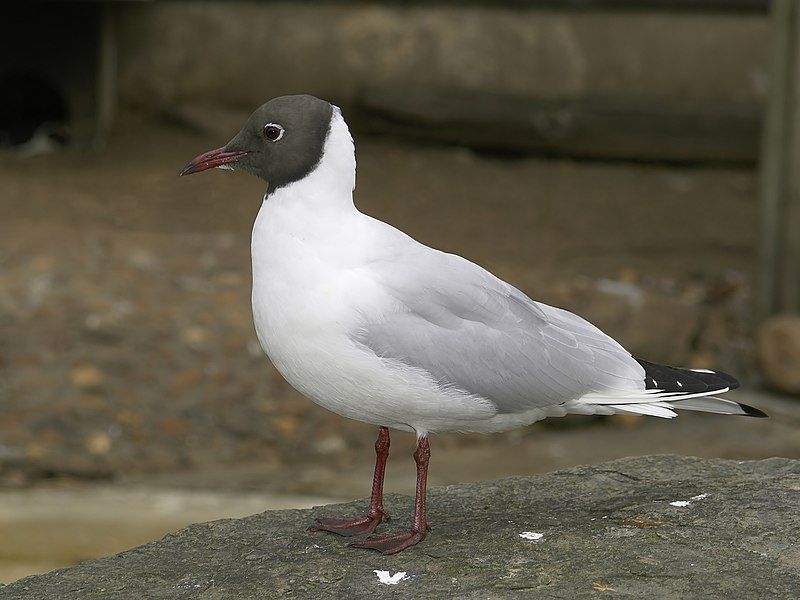
The black-headed gull is a species of small gull that inhabits much of the Palearctic region, including Europe and parts of coastal eastern Canada. This species is mostly migratory, with the majority of the population migrating to warmer, more hospitable regions during winter.
However, some black-headed gulls remain in the milder, westernmost areas of Europe throughout the winter season. These birds usually inhabit coastal areas and are often spotted congregating in large flocks while searching for food.
They are omnivorous and feed on a variety of aquatic and terrestrial prey, including small fish, crustaceans, insects, and carrion. They also often scavenge for food in human-populated areas.
Black-headed gulls form strong pair bonds and usually remain with the same mate throughout their lifetime. The breeding season usually occurs in spring, and during this time they construct their nests on the ground or in shallow water.
The female lays a clutch of 3-4 eggs which are incubated for around three weeks before hatching.
| Kingdom | Animalia |
| Phylum | Chordata |
| Class | Aves |
| Order | Charadriiformes |
| Family | Laridae |
| Genus | Chroicocephalus |
| Species | C. ridibundus |
2. Mallard
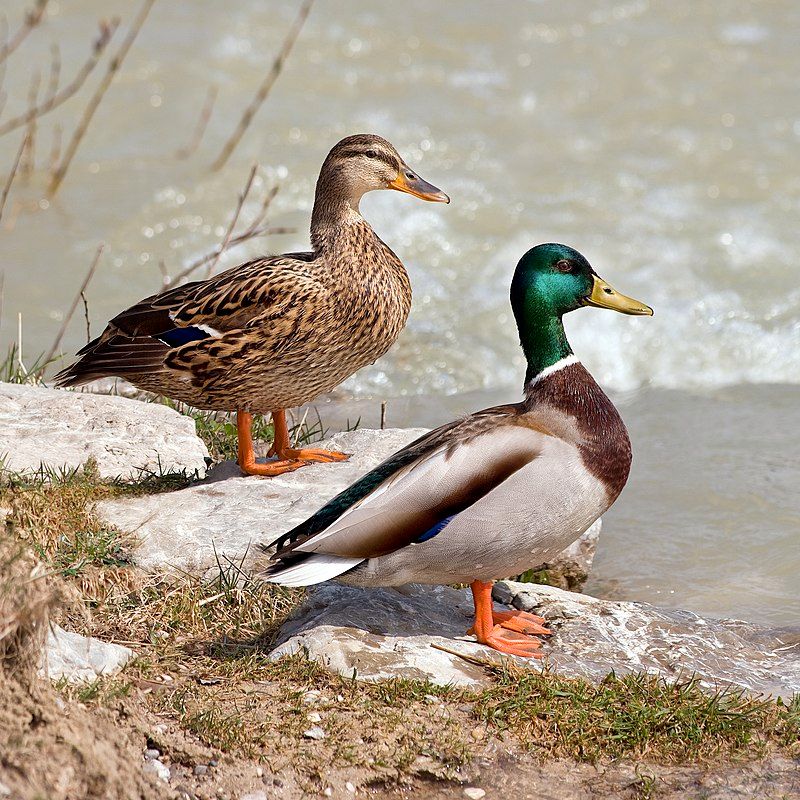
The mallard, also known as the wild duck, is a species of duck that is found across a wide geographic range. It is native to the temperate and subtropical regions of the Americas, Eurasia, and North Africa.
It is a dabbling duck, which means that it feeds by filtering food from the surface of the water.
The Mallard is an adaptable species and has been introduced to many areas outside of its native range, including New Zealand, Australia, Peru, Brazil, Uruguay, Argentina, Chile, Colombia, the Falkland Islands, and South Africa.
Its ability to thrive in a variety of habitats has allowed it to become a successful colonizer in these areas. The Mallard is a popular game bird, and as a result, its populations have been impacted by hunting and habitat loss in some areas.
Despite this, its global population is still considered to be secure.
| Kingdom | Animalia |
| Phylum | Chordata |
| Class | Aves |
| Order | Anseriformes |
| Family | Anatidae |
| Genus | Anas |
| Species | A. platyrhynchos |
3. Greater Flamingo
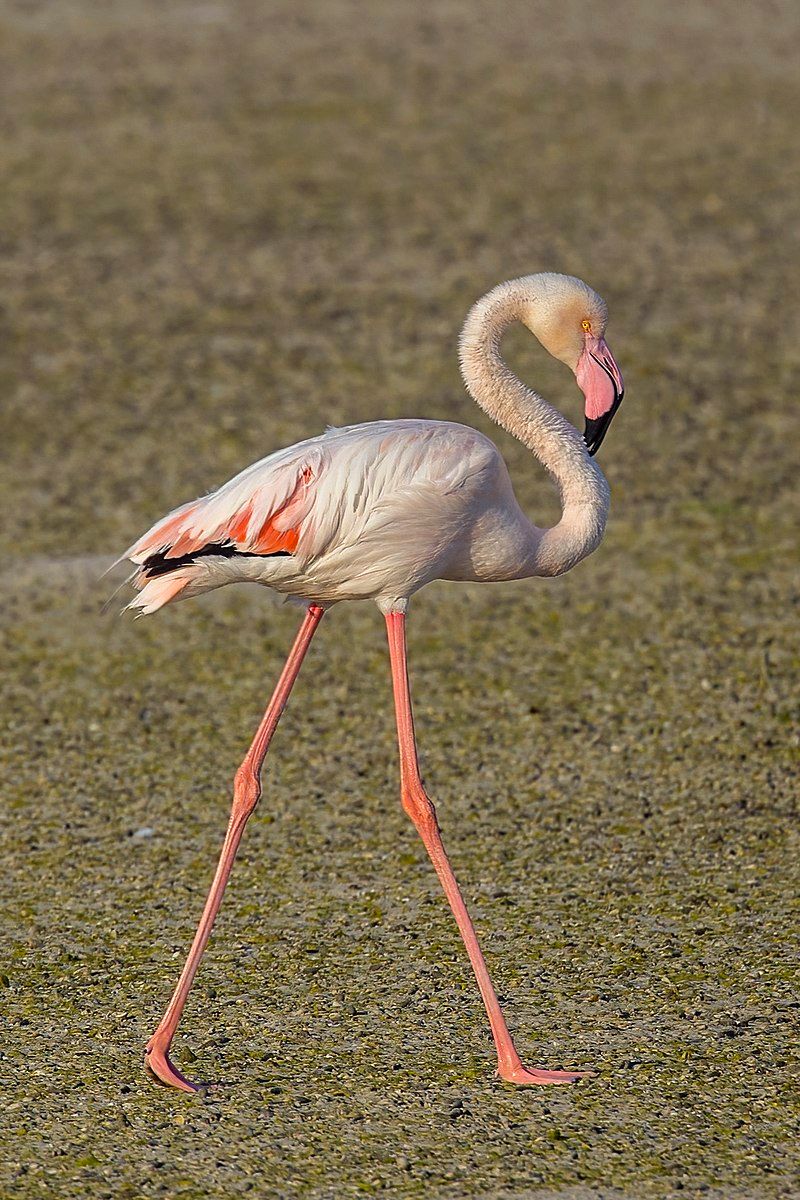
The greater flamingo is the most widespread and largest species of the flamingo family. They are found all over the world, with a particularly large presence in the Old World.
In Northern and Sub-Saharan Africa, these birds can be seen in large numbers, as well as in the Indian Subcontinent, the Middle East, the Levant, the Persian Gulf, the Gulf of Aden, the Red Sea, and the Mediterranean countries of Southern Europe.
The greater flamingo is a very adaptable bird and can survive in a variety of climates and terrains. They prefer warm, shallow, salty waters and can often be found in lagoons, mudflats, and other wetlands.
They feed on a variety of aquatic prey, including algae, small fish, and insects. They also have distinctive courtship behavior, with males and females performing elaborate dances and displays to attract mates.
The greater flamingo is a truly impressive bird and is an important part of the ecosystems it inhabits. It plays an important role in controlling the populations of aquatic creatures that it feeds on, and it is also an important source of food for other predators.
As a result, the greater flamingo is a protected species in many areas and is being monitored and studied to better understand its ecological role.
| Kingdom | Animalia |
| Phylum | Chordata |
| Class | Aves |
| Order | Phoenicopteriformes |
| Family | Phoenicopteridae |
| Genus | Phoenicopterus |
| Species | P. roseus |
4. Red-breasted Merganser
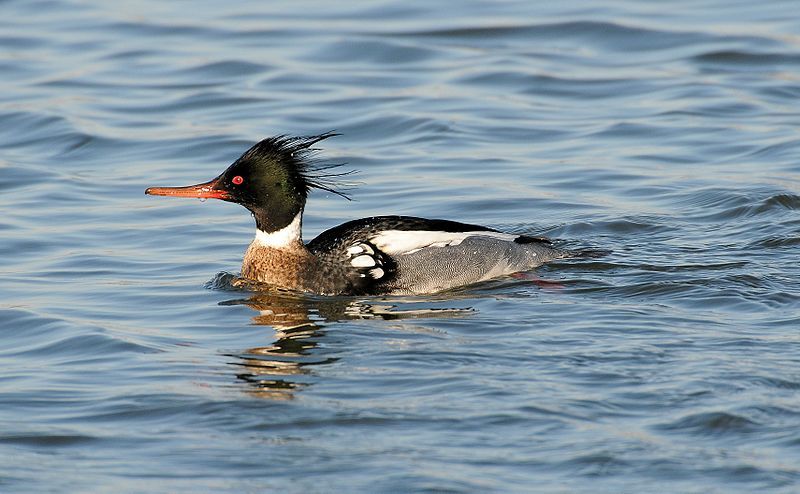
The red-breasted merganser is a species of duck found across the Northern Hemisphere. It is distinctive in appearance, with a unique body shape and black-and-white plumage.
The most recognizable feature of this species is the bright red breast found on males during the breeding season. This is where the species gets its common name. The red-breasted merganser is a large duck, measuring up to 27 inches in length.
It has a long, thin bill and narrow wings. The head is usually black or dark brown, and the body is usually white with black spots. During the breeding season, the male displays its bright red breast, which is not seen in any other duck species.
The female has a much duller plumage, with a grayish-brown head and body, and white or yellowish breasts. The red-breasted merganser is a strong flyer and can often be seen skimming the surface of lakes and rivers.
They are also agile swimmers and can dive underwater in pursuit of fish, crustaceans, and other aquatic prey. The red-breasted merganser is an important species in the wild, helping to keep aquatic ecosystems healthy and balanced.
| Kingdom | Animalia |
| Phylum | Chordata |
| Class | Aves |
| Order | Anseriformes |
| Family | Anatidae |
| Genus | Mergus |
| Species | M. serrator |
5. Osprey
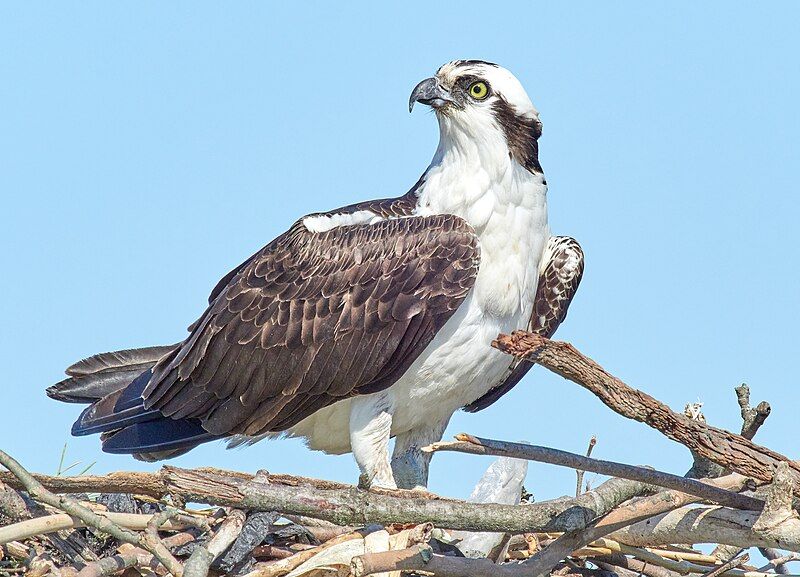
The osprey, also known as the sea hawk, river hawk, and fish hawk, is a majestic bird of prey that has a wide range of habitats. It is a diurnal species, meaning it is active during the day, and it is a carnivorous species that primarily consume fish.
The osprey is a large raptor with a wingspan of 180 centimeters and a length of at least 60 centimeters. Its plumage is mainly brown on the upperparts and grey on its head and underparts.
The Osprey is an adept hunter that can be seen hovering in the sky before diving into the water with powerful strokes of its wings to catch its prey.
Its impressive agility and ability to adapt to different environments make it one of the most successful and recognizable birds of prey in the world.
| Kingdom | Animalia |
| Phylum | Chordata |
| Class | Aves |
| Order | Accipitriformes |
| Family | Pandionidae |
| Genus | Pandion |
| Species | P. haliaetus |
6. Great Bustard
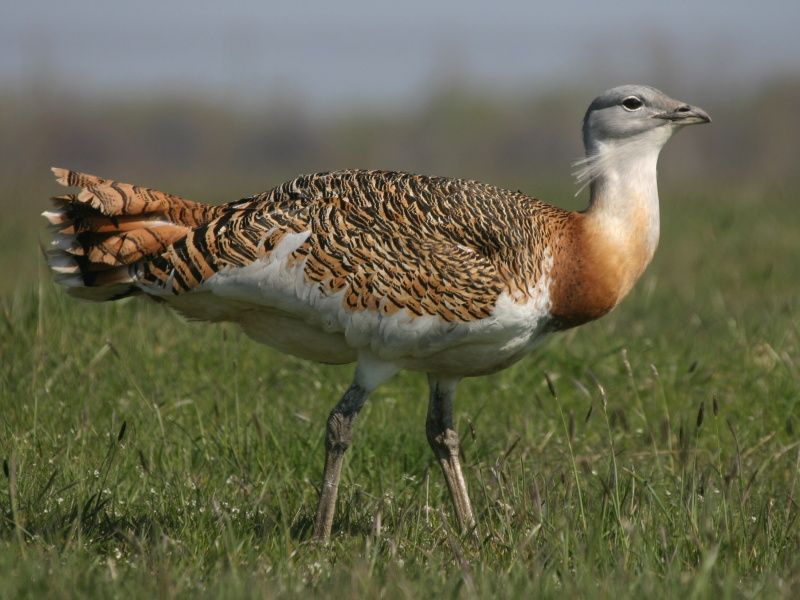
The great bustard is a unique bird belonging to the bustard family. It is the only living species of its genus, Otis.
These birds inhabit open grasslands and farmland across a large range, stretching from northern Morocco, through South and Central Europe, all the way to temperate Central and East Asia.
Great bustards are typically found in dry, open areas such as steppes and prairies, and they tend to avoid dense forests. They feed on a variety of small animals, such as insects, lizards, amphibians, and small mammals, as well as plant material.
Great bustards are a migratory species, traveling south during the winter months. Great bustards are an impressive species, with males weighing up to 15 kilograms.
They have a distinctive white neck with a black stripe down the center, and their plumage is a mix of grey, brown, and black. The males also have a bright yellow eye ring and a yellowish wattle on the back of their neck. The females are smaller and duller in color.
The great bustard is listed as a vulnerable species due to habitat loss and hunting. Conservation efforts are being made to protect these birds and their habitats, such as establishing protected areas and banning hunting.
| Kingdom | Animalia |
| Phylum | Chordata |
| Class | Aves |
| Order | Otidiformes |
| Family | Otididae |
| Genus | Otis |
| Species | O. tarda |
7. Glossy Ibis
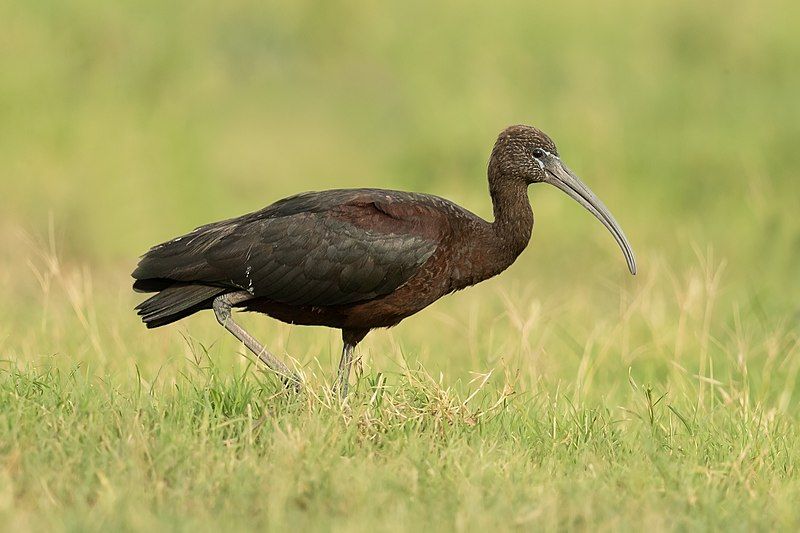
The glossy ibis is a species of water bird that belongs to the order Pelecaniformes and the ibis and spoonbill family Threskiornithidae. This species has a distinctive curved bill shape, which is the source of its scientific name.
The scientific name of the glossy ibis, “plegados falcis,” is derived from Ancient Greek and Latin words that both mean “sickle.” This is due to the curved shape of the bird’s bill, which resembles a sickle.
The glossy ibis is found in various parts of the world, including Europe, Asia, Africa, and the Americas. They inhabit wetlands, swamps, and other areas with shallow water and can be found in both saltwater and freshwater habitats.
The glossy ibis is an important species for wetland conservation, as it is a keystone species that helps maintain the balance of the surrounding ecosystem.
It feeds on small aquatic invertebrates, such as insects, crustaceans, and mollusks, and plays an important role in controlling the populations of these creatures.
| Kingdom | Animalia |
| Phylum | Chordata |
| Class | Aves |
| Order | Pelecaniformes |
| Family | Threskiornithidae |
| Genus | Plegadis |
| Species | P. falcinellus |
8. Black-winged Stilt
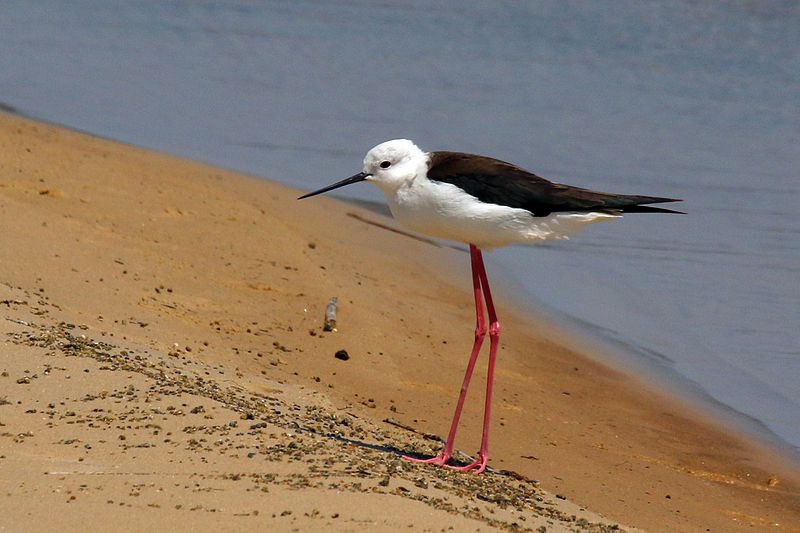
The black-winged stilt is a type of wading bird that belongs to the avocet and stilt family. The bird is widely distributed and has very long legs. It is also known by its scientific name H. himantopus.
This scientific name is sometimes used to refer to a single species that is almost found all over the world. The black-winged stilt is a migratory bird that can be found in many places around the world. It is typically found in wetlands, shallow lakes, and other bodies of water.
It has long, slender legs that help it to wade in the shallow water and hunt for food. Its long black wings have white patches on the tips, which gives the bird its distinctive black-and-white coloration.
The black-winged stilt usually feeds on small aquatic creatures such as insects, crustaceans, and small fish. It also sometimes eats plant matter, such as seeds and aquatic vegetation. Its long legs help it to move quickly through the water while searching for food.
The black-winged stilt is an important species for wetland conservation.
It plays an important role in maintaining the health of wetland ecosystems, as it helps to keep the water clean and healthy by eating the small creatures that would otherwise accumulate in large numbers and cause harm.
The bird is also important for the tourism industry, as its striking colors make it a popular target for birdwatchers. Overall, the black-winged stilt is an important bird that is found across the world.
It is an incredibly important species for wetland conservation and is also a popular target for birdwatchers. Its scientific name is H. himantopus and it is sometimes used to refer to a single, almost cosmopolitan species.
| Kingdom | Animalia |
| Phylum | Chordata |
| Class | Aves |
| Order | Charadriiformes |
| Family | Recurvirostridae |
| Genus | Himantopus |
| Species | H. himantopus |
9. Common Pochard
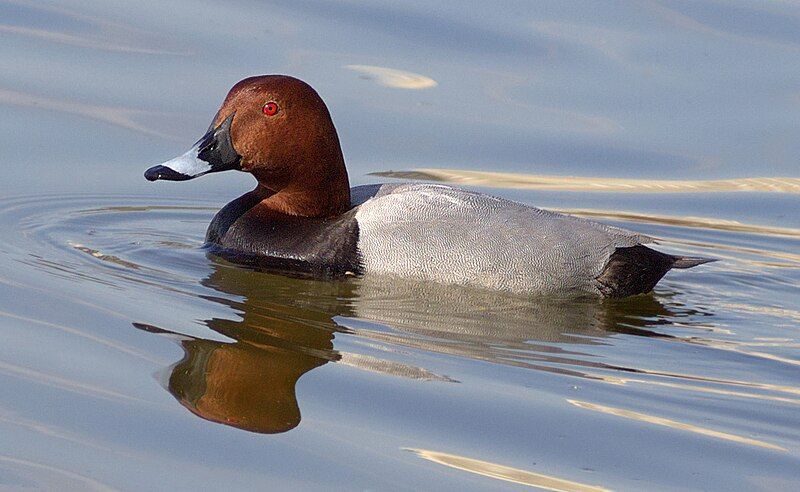
The common pochard is a medium-sized diving duck, whose scientific name is derived from ancient Greek. The Greek word ‘aithuia’ is mentioned by authors including Hesychius and Aristotle and this word is used to refer to an unidentified seabird.
Additionally, the Latin term ‘ferina’ is used to mean “wild game” with ‘ferus’ meaning “wild”. This reflects the common pochard’s wild nature, as it is a diving duck found in many parts of the world.
| Kingdom | Animalia |
| Phylum | Chordata |
| Class | Aves |
| Order | Anseriformes |
| Family | Anatidae |
| Genus | Aythya |
| Species | A. ferina |
10. Ferruginous Duck
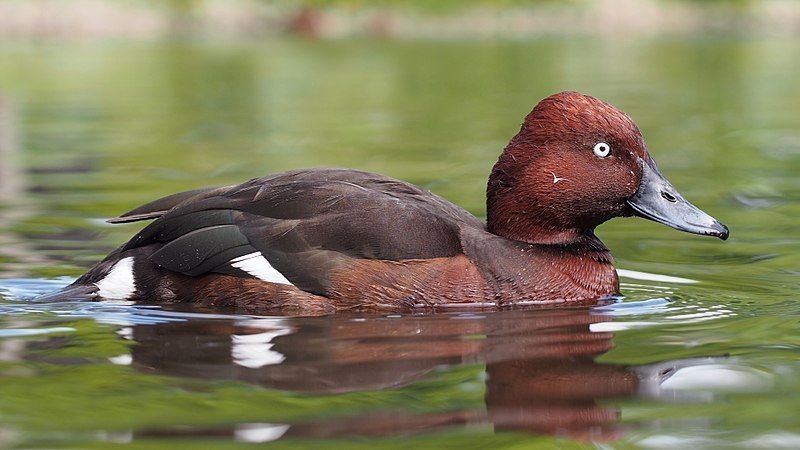
The ferruginous duck, also known as the ferruginous pochard, common white-eye or white-eyed pochard, is a species of diving duck that is native to Eurosiberia. It is a medium-sized duck, with an average body length of about 20 inches, and a wingspan of about 30 inches.
The scientific name for the species, Aythya nyrok, is derived from Greek, where Aythya is an unidentified seabird mentioned by authors such as Hesychius and Aristotle, and Nyrok is the Russian name for a duck. The ferruginous duck has reddish-brown plumage, and its head and neck are covered in white feathers.
The bill is yellow and the legs are gray. The male and female have similar markings, but the male is slightly larger than the female. The ferruginous duck is an excellent swimmer, and it uses its webbed feet to dive for food, such as aquatic plants, crustaceans, and mollusks.
It is also an excellent diver and can stay underwater for up to four minutes at a time. The ferruginous duck is found in shallow wetlands, ponds, marshes, and lakes. It is also found in coastal areas, such as rivers and estuaries.
It breeds in the summer months, laying up to six eggs in a nest made of grass and reeds. The ducklings are able to swim almost immediately after hatching. The ferruginous duck is listed as a species of Least Concern by the IUCN Red List.
It is a protected species and is found in a number of protected areas across its range. The population is believed to be stable, and the species is not considered to be threatened in the near future.
| Kingdom | Animalia |
| Phylum | Chordata |
| Class | Aves |
| Order | Anseriformes |
| Family | Anatidae |
| Genus | Aythya |
| Species | A. nyroca |
11. Gadwall
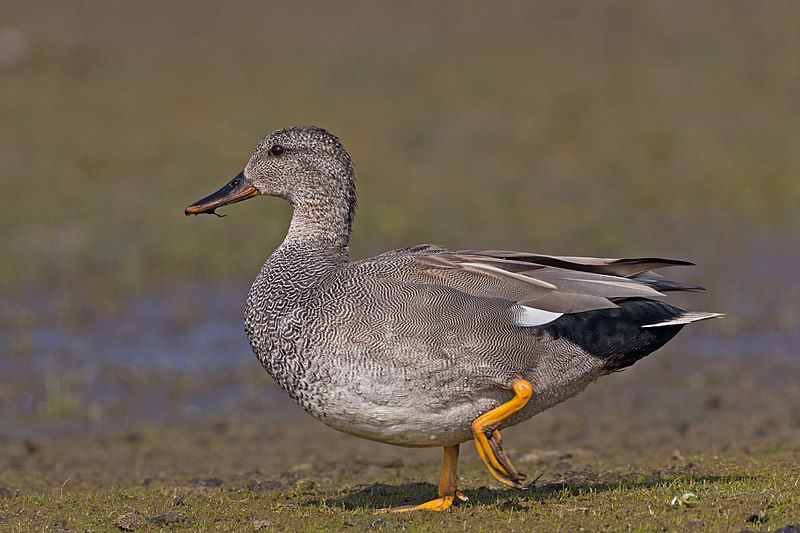
The gadwall is a species of duck that belongs to the family Anatidae. It is known for its widespread distribution and is one of the most common dabbling ducks in the world.
It is a medium-sized duck, with males measuring between 56 and 60 cm in length while females measure between 54 and 58 cm. The gadwall is easily identified by its gray-brown body, white breast, and gray head.
Its tail is blackish-brown in color and it has white speculum patches on its wings. It has a wide variety of habitats, ranging from small ponds to large wetlands, and can even be found in estuaries and on lakes.
It feeds mainly on aquatic vegetation, including aquatic plants, grasses, and insects.
During the breeding season, it typically nests in shallow depressions in the ground, lined with down and other plant material. Gadwalls are highly social birds and will often form large flocks during the winter months.
They are known for their loud, melodious honks that often carry over long distances. The gadwall is considered a beneficial species, helping to control aquatic vegetation and providing food for other wildlife.
All in all, the gadwall is an important species in wetland ecosystems and is widely appreciated by birdwatchers around the world.
| Kingdom | Animalia |
| Phylum | Chordata |
| Class | Aves |
| Order | Anseriformes |
| Family | Anatidae |
| Genus | Mareca |
| Species | M. strepera |
12. Marbled Teal
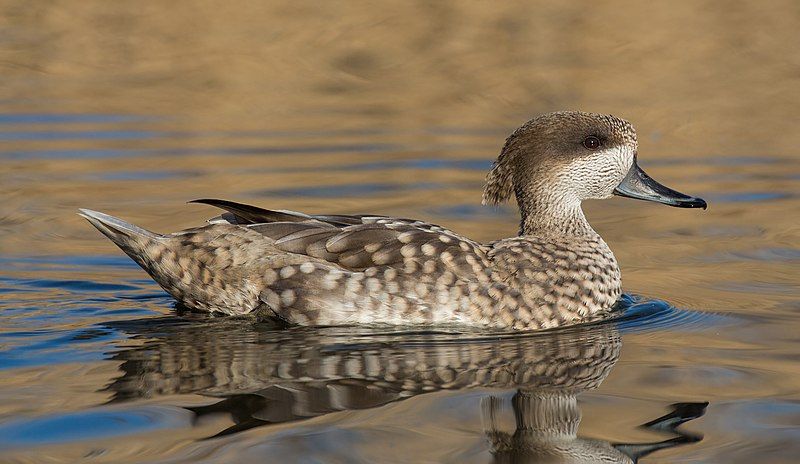
The marbled duck, also known as the marbled teal, is a species of duck that is found in many areas around the world. Its range extends from southern Europe, to northern Africa, and across western and central Asia.
Its scientific name is Marmaronetta angustirostris, which is derived from both Greek and Latin words. The Greek word marmaros means marbled, and Netta is a type of duck. In Latin, angustus means narrow or small, and -rostris means billed.
This species of duck is medium-sized and is characterized by its distinctive marbled pattern and narrow bill.
| Kingdom | Animalia |
| Phylum | Chordata |
| Class | Aves |
| Order | Anseriformes |
| Family | Anatidae |
| Genus | Marmaronetta |
| Species | M. angustirostris |
13. White-headed Duck
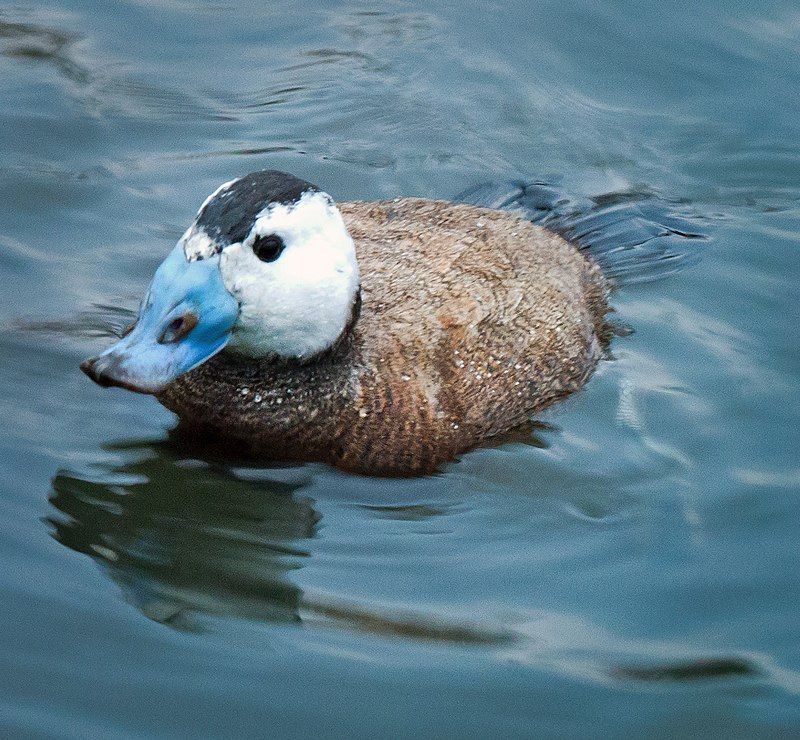
The white-headed duck is a small diving duck that is 45 cm in length. The male of this species has a white head with a black crown, a blue bill, and reddish-grey plumage. The female, on the other hand, has a dark bill and duller coloration.
In terms of its breeding habitat, this duck prefers lakes with open water and dense vegetation at the edges. This kind of vegetation provides the duck with shelter from predators and also provides a source of food.
The white-headed duck is able to dive into the water for food, and the dense vegetation around the lake also provides a safe place for it to hide and nest. This kind of habitat is essential for the white-headed duck in order to survive and reproduce successfully.
| Kingdom | Animalia |
| Phylum | Chordata |
| Class | Aves |
| Order | Anseriformes |
| Family | Anatidae |
| Genus | Oxyura |
| Species | O. leucocephala |
14. Common Gull
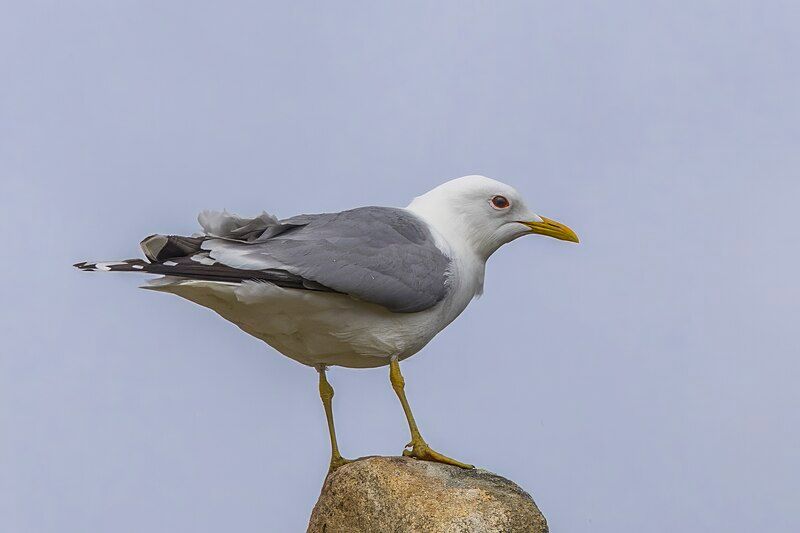
The Common Gull or Sea Mew is a species of seagull that is found in the Palearctic region. It is a medium-sized gull, with a wingspan of up to 32 inches. It is closely related to the Short-billed Gull, which is sometimes considered to be the same species.
Because of this, the two species are sometimes collectively referred to as the ‘Mew Gull’.The Common Gull is a migratory species, and in the winter months, it can be found in more southerly locations.
This species is particularly abundant around the coasts of Europe and the British Isles, but they have also been recorded in Africa, the Middle East and Asia. The Common Gull is a gregarious species, and it typically feeds on fish, molluscs, crustaceans, and insects.
They are known to steal food from other gull species, as well as from terns and other birds.
They will also scavenge for food in urban areas, particularly near harbours and landfill sites. In terms of its physical characteristics, the Common Gull is a medium-sized gull with a white head, neck, and underparts.
Its back and wings are grey, and its tail is white with a black terminal band. The bill and legs are yellow, and the eyes are dark brown.
| Kingdom | Animalia |
| Phylum | Chordata |
| Class | Aves |
| Order | Charadriiformes |
| Family | Laridae |
| Genus | Larus |
| Species | L. canus |
15. Common Redshank
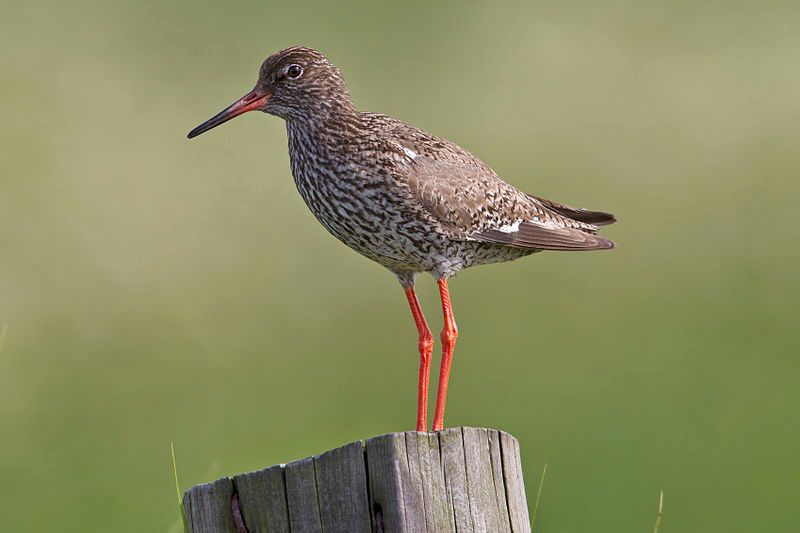
The Common Redshank is a species of shorebird belonging to the Scolopacidae family. It is a Eurasian water, meaning that it is found in wetland areas of Europe and Asia.
The Common Redshank is a medium-sized wader, measuring approximately 27cm in length and having a wingspan of approximately 45-50cm. Its plumage is predominantly grey-brown in color, with a white rump and black legs.
The Common Redshank is most easily distinguished by its red bill and red legs, which contribute to its namesake. The Common Redshank is a migratory species, traveling south during the winter months and returning north for the breeding season.
During the breeding season, the Common Redshank is found in wetland areas of Europe, Asia, and North Africa. It feeds mainly on small invertebrates, such as worms and insect larvae, which it hunts by probing in the mud with its long bill.
The Common Redshank is also known to take small fish, crustaceans, and mollusks. The Common Redshank is an important species of wader, providing important ecosystem services such as controlling insect pests and cleaning wetlands.
It is also a popular game bird, with its hunting season typically taking place between mid-September and late January.
The population of the Common Redshank has declined in recent years due to habitat destruction, pollution, and over-hunting, but it is still listed as a species of least concern by the IUCN.
| Kingdom | Animalia |
| Phylum | Chordata |
| Class | Aves |
| Order | Charadriiformes |
| Family | Scolopacidae |
| Genus | Tringa |
| Species | T. totanus |
16. Eurasian Griffon
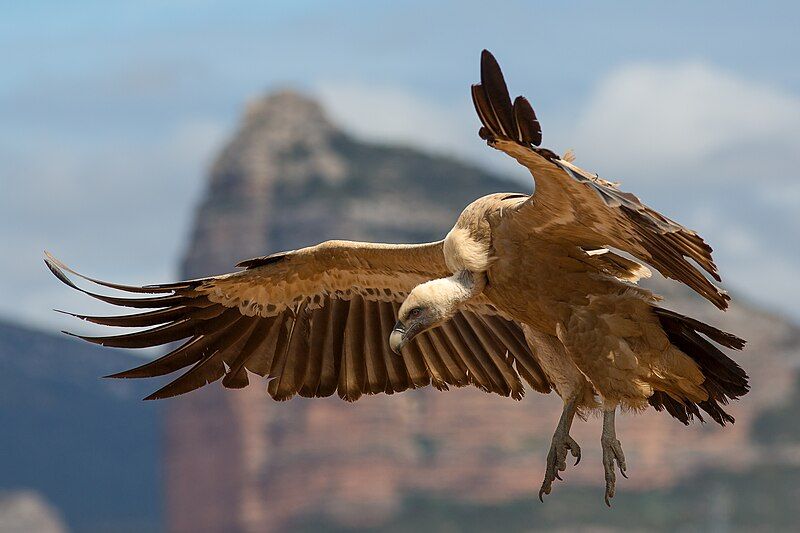
The Eurasian griffon vulture is a large bird of prey that belongs to the Old World family Accipitridae. It is also commonly referred to as the Griffon vulture, though this term is sometimes used to refer to the entire genus of vultures.
It is important to note that the Eurasian griffon vulture should not be confused with two other species of griffon vultures, Rüppell’s griffon vulture and the Himalayan griffon vulture.
The Eurasian griffon vulture is a large bird, with an impressive wingspan of up to 2.5 meters. Its body is covered in brown-black feathers, with a light-colored head, neck, and belly. Its beak is curved and sharp, and its talons are designed for grasping and tearing food.
The Eurasian griffon vulture is a scavenger, primarily feeding on carrion, but will also feed on eggs and small animals.
They can often be seen soaring high in the sky, searching for carrion. Though the Eurasian griffon vulture is found throughout Europe and Asia, its population has been decreasing due to human activities.
These activities include hunting, deforestation, and the use of pesticides, which have caused a decrease in their food sources. Conservation efforts have been put in place to protect the species and increase its population numbers.
| Kingdom | Animalia |
| Phylum | Chordata |
| Class | Aves |
| Order | Accipitriformes |
| Family | Accipitridae |
| Genus | Gyps |
| Species | G. fulvus |
17. Northern Pintail
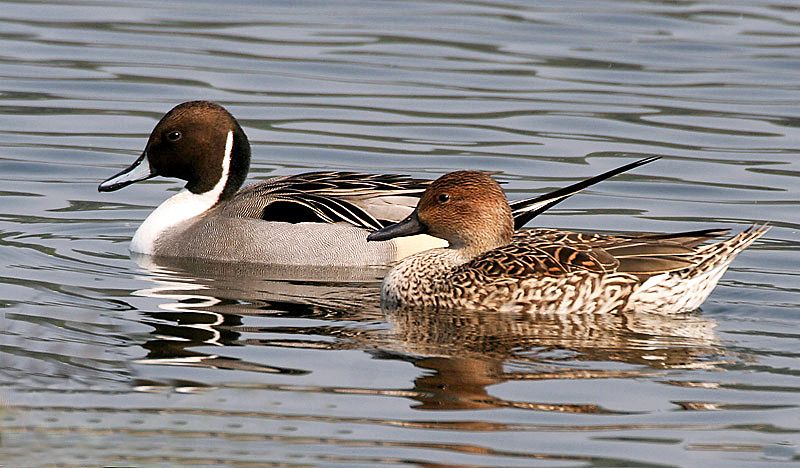
The pintail or northern pintail is a migratory duck species with a widespread geographical range. It breeds in northern Europe, the Palearctic, and North America, and migrates south of its breeding range to winter in more tropical climates near the equator.
The species is a long-distance migrant, traveling thousands of kilometers between habitats. During winter, they can be found in a variety of habitats, ranging from open wetlands and coastal lagoons to flooded fields and shallow lakes.
In the summer, they breed in grassy wetlands such as marshes, wet meadows, and bogs. The northern pintail is a medium-sized bird, with a long neck, long legs, and a long, pointed tail. The male has a chocolate-brown head, white breast, and grey back.
The female has a mottled brown head and body, with a white belly.
They are active mainly during the day and feed by dabbling and diving for aquatic plants and small fish, and sometimes insects. The northern pintail is an important species for conservation, as it is seen as an indicator of the health of wetlands.
It is listed as Least Concern on the IUCN Red List, although its population has declined in some parts of its range due to habitat loss and hunting.
Its conservation status is of particular importance, as it is an indicator species and a key component of healthy wetland ecosystems.
| Kingdom | Animalia |
| Phylum | Chordata |
| Class | Aves |
| Order | Anseriformes |
| Family | Anatidae |
| Genus | Anas |
| Species | A. acuta |
18. Northern Shoveler
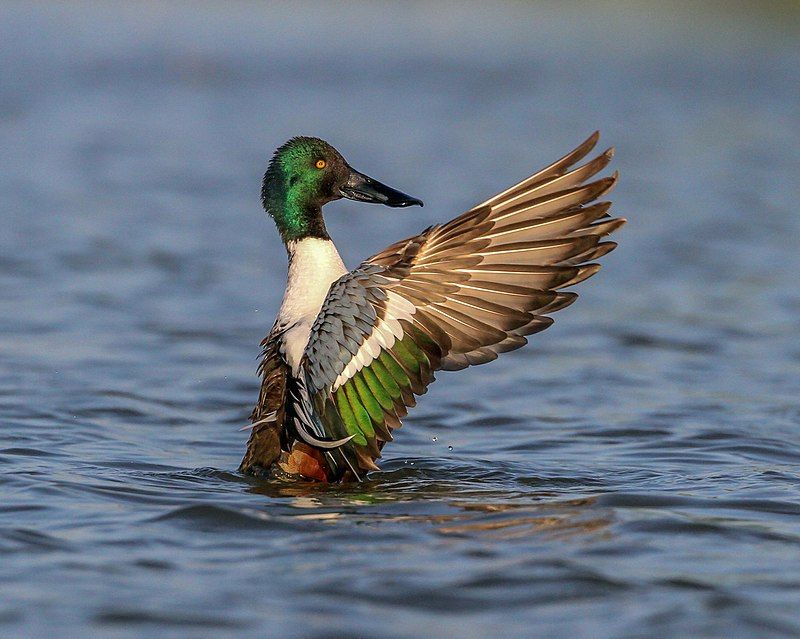
The northern shoveler is a distinctive species of duck found in many areas around the world. It is native to Europe, as well as the Palearctic region, which includes parts of Asia and North Africa.
In North America, it is found across the continent, from the northern regions of Canada and Alaska, south to parts of the United States.
During the winter months, the northern shoveler migrates to more temperate climates, including southern Europe, the Indian subcontinent, Southeast Asia, Central America, the Caribbean, and northern South America.
The northern shoveler is an easily recognizable duck, with a long, broad bill, and a distinctive bright green head. It is a large duck, measuring up to 24 inches long and weighing up to two pounds.
Male shovelers have bright chestnut-colored wings, while females are more mottled, with brown and black feathers.
The shoveler has a loud, distinctive honking call, which can often be heard near ponds and other wetlands where it often feeds. The northern shoveler feeds on aquatic invertebrates, such as aquatic insects, crustaceans, and mollusks.
It also feeds on a variety of seeds, plant material, and small fish. The shoveler uses its long bill to filter food from the water, which it then swallows.
It is also an adept flier, and can often be seen in large flocks in the sky. The northern shoveler is a common and widespread species of duck and can be found in many areas around the world. It is an important species for hunters and is a popular game bird in some areas.
The shoveler is also a popular subject for birdwatchers, and its distinctive call and bright plumage make it a distinctive sighting in many wetlands and waterways.
| Kingdom | Animalia |
| Phylum | Chordata |
| Class | Aves |
| Order | Anseriformes |
| Family | Anatidae |
| Genus | Spatula |
| Species | S. clypeata |
19. Ruddy Duck
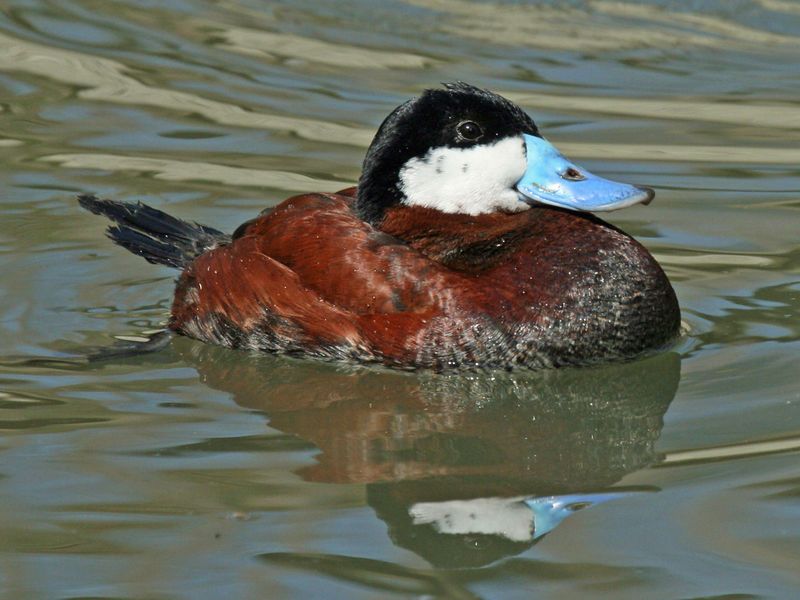
The ruddy duck is a species of duck native to North America and is part of the stiff-tailed duck family. Its scientific name, Oxyura jamaicensis, is derived from Ancient Greek words; oxus meaning ‘sharp’ and oura meaning ‘tail’.
The second part of its name, jamaicensis, stems from the Latin ‘jamaicensis’ meaning ‘from Jamaica’, referencing where the bird was first described. The ruddy duck is easily identified by its distinctive tail, which points upwards and is composed of stiff feathers.
The male ruddy duck is a bright chestnut color with a blue bill, while the female is a paler brown color with a dark brown bill. The bird’s diet consists of mostly aquatic plants and invertebrates, which it forages for in shallow waters.
It is known to nest near the edges of ponds or lakes and will use aquatic vegetation to construct a nest. The ruddy duck is a popular species among birdwatchers, as its colorful feathers make it stand out in the landscape.
It is also a popular game bird, as its size and easy accessibility make it an attractive hunting target. Despite its popularity, the ruddy duck has seen a decrease in population due to habitat destruction and overhunting.
As a result, it has been listed as a species of conservation concern in some areas.
| Kingdom | Animalia |
| Phylum | Chordata |
| Class | Aves |
| Order | Anseriformes |
| Family | Anatidae |
| Genus | Oxyura |
| Species | O. jamaicensis |
20. Great Spotted Cuckoo
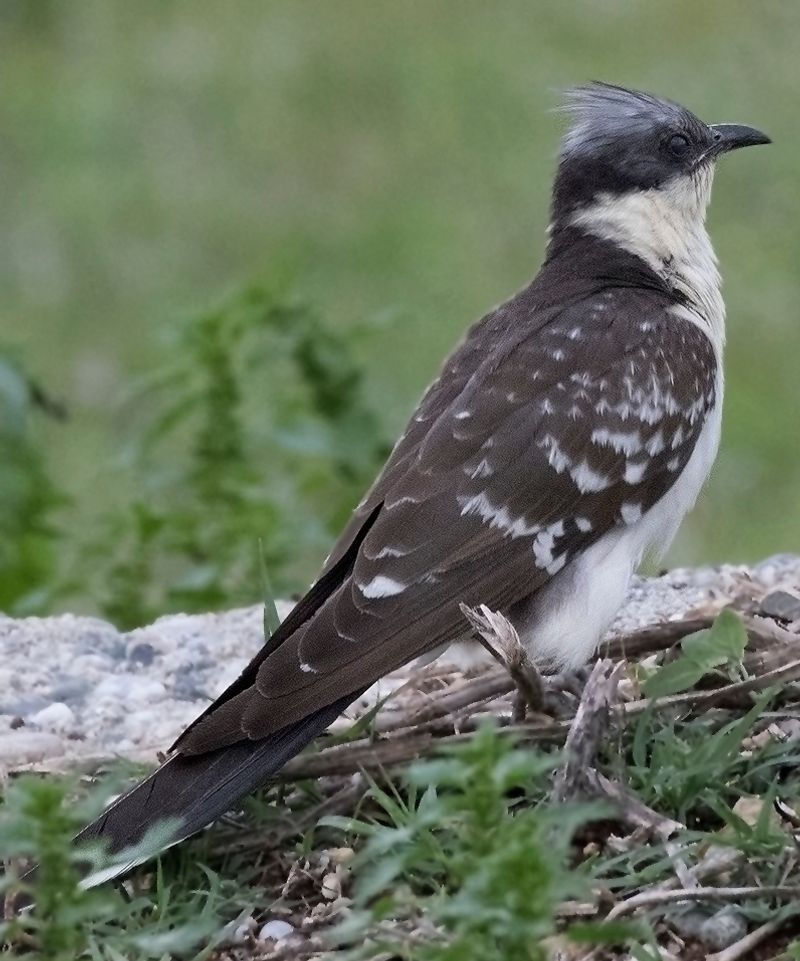
The great spotted cuckoo is an avian species commonly found throughout Africa and the Mediterranean Basin. It is a member of the Cuculiformes order, which includes other birds such as roadrunners, anis, and coucals.
It is a brood parasite, meaning it lays its eggs in other birds’ nests. The main host species of the great spotted cuckoo is the Eurasian magpie, but it has been known to lay its eggs in the nests of other corvid species.
The young cuckoo chick hatches before the host chicks, giving it an advantage in terms of food and survival. The host parents will then take care of the cuckoo chick as if it were their own.
This behavior is known as “brood parasitism,” and it is an effective way for the great spotted cuckoo to ensure its young will survive.
| Kingdom | Animalia |
| Phylum | Chordata |
| Class | Aves |
| Order | Cuculiformes |
| Family | Cuculidae |
| Genus | Clamator |
| Species | C. glandarius |
21. Black-legged Kittiwake
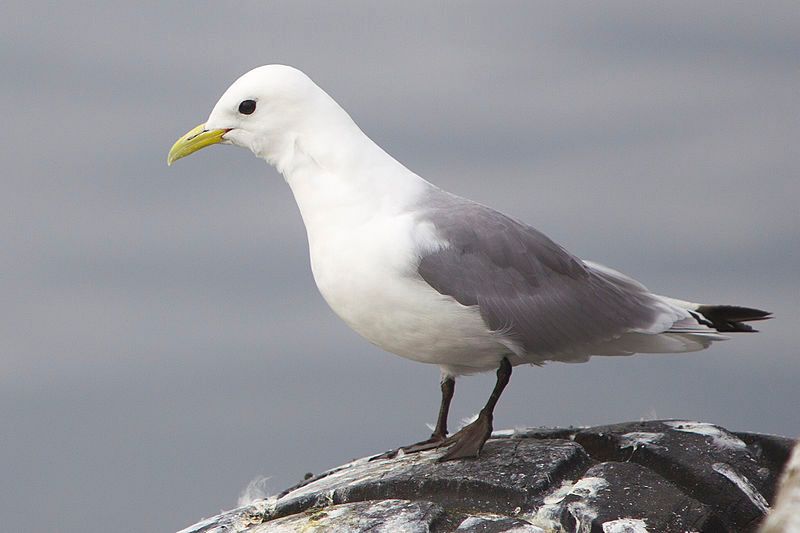
The black-legged kittiwake is a species of seabird that belongs to the gull family called Laridae. It was first identified and given a scientific name by the famous biologist Carl Linnaeus in the 10th edition of his book Systema Naturae, published in 1758.
The scientific name he gave this species was Larus tridactylus. The English name of this species, kittiwake, is derived from its call, which is a shrill ‘kittee-wa-aaake, kitte-wa-aaake’.
These birds are found mainly in the northern hemisphere, and they live in colonies near coastal areas. They have a black bill, a white head and neck, and a grey-brown body with black legs. They typically feed on small fish, crustaceans, and other aquatic invertebrates.
Kittiwakes are considered to be a sign of good luck by many cultures and have been featured in many works of art. They are also highly valued by scientists, as they are one of the few species of birds that show an ability to adapt to changing environmental conditions.
This makes them an important indicator species, helping us to understand the effects of climate change on the environment.
| Kingdom | Animalia |
| Phylum | Chordata |
| Class | Aves |
| Order | Charadriiformes |
| Family | Laridae |
| Genus | Rissa |
| Species | R. tridactyla |
22. Cattle Egret
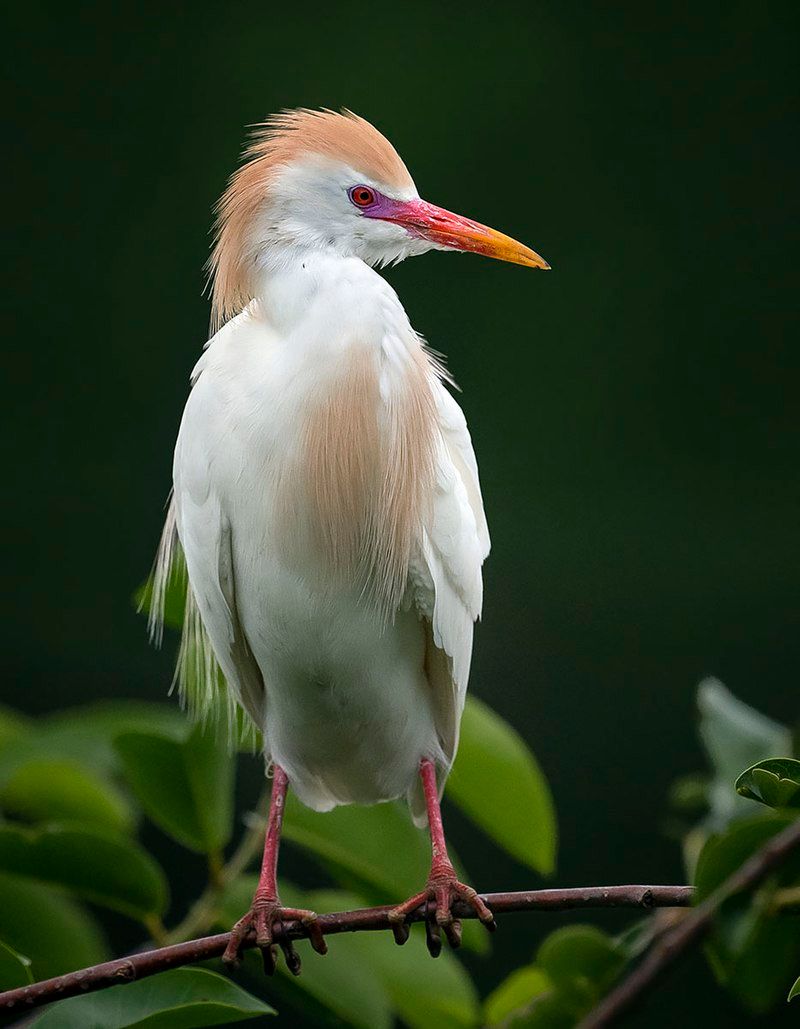
The cattle egret is a type of heron that is found across the world in tropical, subtropical, and warm-temperate regions. It is the only known species in its genus, Bubulcus. However, some experts believe that there are two separate species, the western and eastern cattle egrets.
The western species is typically found in western Africa, the Caribbean, and parts of southern North America, while the eastern species is found in eastern Africa, India, and some parts of Southeast Asia.
Both species have white feathers and yellow bills, but the eastern species has longer legs and a thicker neck. They are both primarily found in wetlands, grasslands, and agricultural fields, and they feed on a variety of insects, frogs, and small mammals.
They are also known to form large flocks when foraging, which helps them to spot potential predators and escape quickly.
| Kingdom | Animalia |
| Phylum | Chordata |
| Class | Aves |
| Order | Pelecaniformes |
| Family | Ardeidae |
| Genus | Bubulcus |
| Species | B. ibis |
Conclusion
Birds in Tangier are a beautiful and diverse part of the natural environment. They provide a unique opportunity to observe a variety of species in their natural habitat.
Birds also play an important role in the environment, providing food to other animals and helping to maintain a healthy ecosystem. The city of Tangier is an important breeding ground for many species of birds, making it a great place to enjoy bird watching.
Bird watching in Tangier is a great way to connect with nature and appreciate the beauty of the birds.